Transplant and reproduction
Wild peonies grow in one place for up to 100 years, but their cultural counterparts need a transplant every 10 years.
When a plant needs to be transplanted or it is necessary to divide a bush, then it is carefully dug out, avoiding mechanical damage to the roots. The root system of peonies is powerful, with a fragile fleshy rhizome with tuberous thickenings. The root lies quite deep for herbaceous plants, so it must be dug out with a pitchfork. Having dug the bush in a circle to a sufficient depth, carefully pry it with a shovel and remove it from the soil.
The removed root is shaken off the ground, washed and placed in the shade, allowing it to wither slightly to get rid of excessive fragility. Old thick roots are cut off at an angle of 45 °, leaving only 10-15 cm in length. Large rhizomes must be divided. To do this, use a peg, which is driven into the middle of the root, after which several parts with eyes are obtained. The division of roots is carried out for plants at least 5-6 years old.
Often the middle of the rhizome of peonies is empty, so each new part must be carefully inspected to remove rotten and damaged places. Treat the sections with a solution of potassium permanganate and sprinkle with fungicide.
The planting hole is prepared a month before the start of autumn work. In a prepared hole about 60 cm deep, 2/3 is covered with a substrate from a mixture of earth, peat, humus and sand, adding wood ash, superphosphate and a little copper sulfate. Planting is carried out in a prepared hole so that the buds are located at a depth of 3-5 cm. On top of the cut, they cover it with earth and mulch with a layer of peat no more than 5 cm.
Peonies are propagated by dividing the bush and seeds. But due to the fact that it is difficult to obtain the original variety from seeds, this method is used only by breeders to create new plant species. The rest use the division of the bush.
Peonies from divisions bloom in the second or third year, but varietal signs in them can appear only after four or five years with proper care:
- all buds on a one-year-old seedling are completely removed;
- in the second year, one bud is left, waiting for its flowering to see the presence of varietal characteristics, after which it is also removed, cutting it as short as possible;
- such an operation is carried out all subsequent years, waiting for the plant to bloom with the required color.
When this happens, you will never regret the effort and the long wait for the result.
For information on how to plant peonies correctly in autumn and spring, see the next video.
Description of peony Karl Rosenfield
Peony Karl Rosenfeld belongs to herbaceous, milky-flowered varieties. The plant was bred in the south of China and, thanks to its beauty, became the property of the country. Despite its southern roots, the variety is cold-resistant and can withstand severe frosts without shelter. The flower grows poorly only in the Far North.
Acquaintance with the peony Karl Rosenfeld must begin with external characteristics. The plant forms a powerful, spreading bush, up to one meter high. Strong, thick shoots are covered with delicate foliage of light olive color.
The surface of the plate is smooth and shiny. Closer to autumn, the lush crown acquires a reddish tint, which allows you to maintain a decorative appearance until late autumn.
Peony Karl Rosenfeld has gained popularity for its beautiful flowering. Large inflorescences appear only when grown in the open sun. Thanks to thick shoots and strong peduncles, the bush does not break or bend under the weight of flowers.Therefore, the plant does not need a garter. But many flower growers, due to their spreading shape, to give a decorative look, the bushes are installed in a beautiful support.
To have an idea of the beauty of the Karl Rosenfield peony, you need to view the photo:
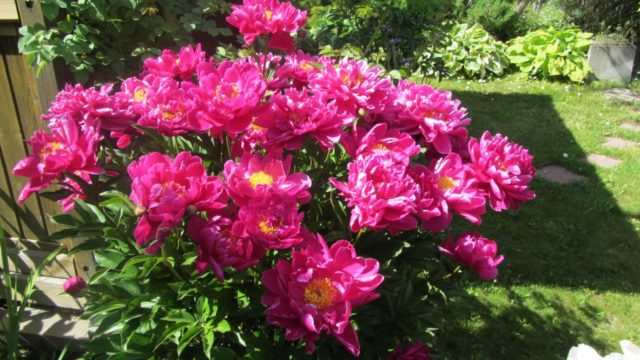
Flowers are large, double, serve as a real garden decoration
Flowering features
Peony Karl Rosenfeld belongs to herbaceous, medium late varieties. Flowering begins in early July and lasts about 2 weeks. Due to its beautiful flowers, the variety is often used for making bouquets. To extend the flowering time when cut, sugar and vinegar are added to the water. In this case, the water is changed daily.
- flowers are arranged singly, double or simple in shape;
- the structure is dense, large, 18 cm in size;
- the color of the flower is dark red with a purple tint;
- petals are large, ribbed, bent in waves;
- The aroma is sweet, attracting butterflies and pollinating insects.
Lush and long flowering depends on the place of growth, climatic conditions and adherence to agricultural practices. If all the care requirements are met, the bush will become a decoration of the summer cottage for a long time.
Application in design
Herbaceous peony Karl Rosenfeld is ideal for the embodiment of designer fantasies
But before decorating a flower garden, it is important to know what the peony is combined with.
Peony planting scheme Karl Rosenfeld:
- 3-4 plants are planted in the center of the flower garden, herbaceous or ground cover plants are placed around it.
- Peony is in perfect harmony with hybrid tea roses. While the rosebush is forming buds, Rosenfeld is already showing lush bloom. After it ends, the rose shows itself in all its glory, and the bright inflorescences look harmoniously against the background of the green foliage of the peony bush.
- Peony Karl Rosenfeld is suitable for creating mixborders. It is planted surrounded by garden geraniums, cuffs, ornamental onions and aquilegia.
- In order for the flower bed to delight the whole season with beautiful flowering, peonies are planted in combination with Siberian iris, large-rhizome geraniums, sedum, yarrow and common mordovia.
Flowers of the Buttercup family are not compatible with herbaceous peonies. Hellebore, anemone, lumbago quickly deplete the soil. Therefore, when growing together, peonies will not show a lush and beautiful flowering.
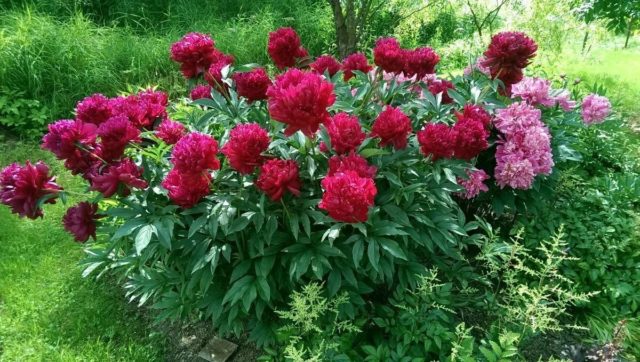
The variety goes well with herbaceous and flowering plants.
When creating a flower garden with a peony of the Karl Rosenfeld variety, it is important to remember that he:
attracts attention;
loves open sun and nutritious soil;
grows in one place for about 20 years;
because of the spreading, it requires a lot of space.
With the right combination of colors, the flower bed will become a decoration of the personal plot, it will bloom from early summer to late autumn.
Peony Red Charm (Paeonia Red Charm) - what kind of variety, history of creation
This is a variety of American origin, which was obtained back in 1944. Since that time, he has gained more and more fans. In China, culture symbolizes happiness and prosperity.
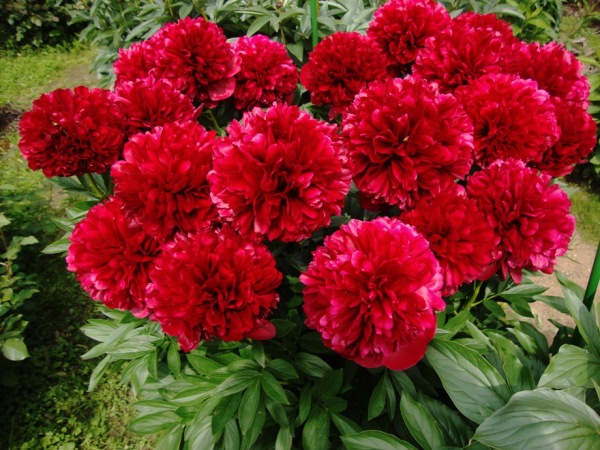
This peony looks very attractive.
Brief description, characteristic
Before planting a culture, it is worth studying its description. Paeonia of the Red Charm cultivar belongs to the category of milk-flowering crops. The plant is characterized by shiny terry inflorescences that have a bomb-shaped shape and a bright red tint.
This variety is considered the best crimson hybrid. It blooms for 2 weeks and begins in May or June. The diameter of the flowers reaches 20-22 cm.
Mature shrubs reach 80 cm in height. They are characterized by strong stems and carved leaves. The crop is frost-resistant and has a light aroma.
Important! It is recommended to plant bushes in sunny areas in well-drained soil. In this case, an interval of at least half a meter must be observed.
Advantages and disadvantages of the variety
Peony Red Charm has many benefits:
- excellent decorative properties;
- the possibility of using for decorating bouquets;
- light pleasant aroma;
- lush and double inflorescences;
- the ability to use in landscape design.
At the same time, peony Charm also has certain disadvantages. For example, a plant can be attacked by pests and suffer from fungal infections. Therefore, it needs to be sprayed periodically.
Use in landscape design
Peony varieties Red Sharm are mainly used to decorate gazebos, paths, borders. With these flowers, you can create interesting flower beds.
Bushes go well with other plants. They can be combined with geraniums, irises, poppies. A good addition to peonies will be a foxglove. Also, the culture can be combined with other varieties of peonies - for example, Red Sarah Bernhardt.
Important! In autumn, the leaves of the plant acquire a burgundy color. This feature can be used when composing effective compositions.
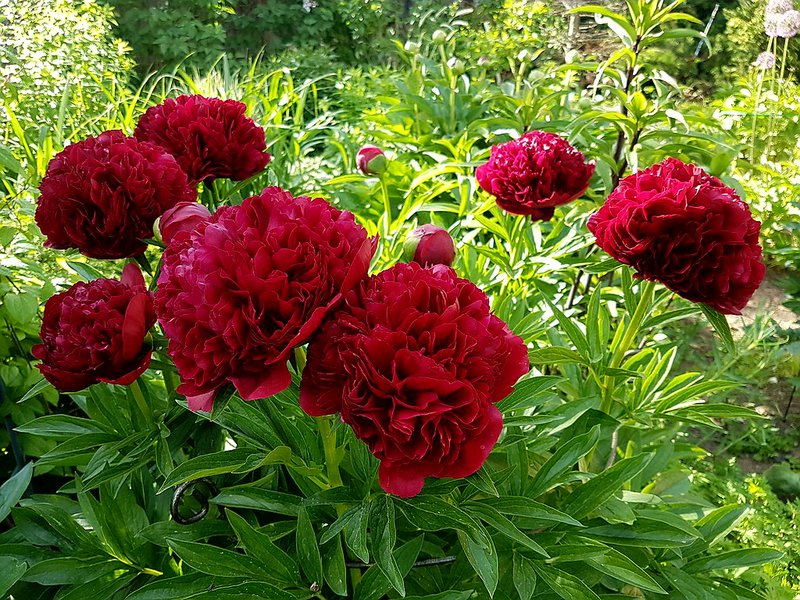
The plant is actively used to decorate flower beds.
Plant care
Peony care activities include the usual treatments for flowering horticultural crops. Raspberry bushes need to be watered and fed regularly, and the soil under them should be loosened.
It is recommended to mulch peonies
Watering and feeding
In the spring, peonies are fed with urea or ammonium nitrate with the addition of nitroammophoska. In the fall, complex mineral compositions that do not contain nitrogen are introduced under the bush.
The soil under an adult bush is moistened as the soil dries out. At the end of May, when it is time for flowering, and in August, when flower buds are laid, the plant should receive enough water (15-20 liters once a week).
Mulching and loosening
The peony bush must necessarily have a trunk circle. No other plants are planted inside this space, weeds are removed regularly.
In spring, it is recommended to mulch peonies with horse manure, but not with leaves or straw. If fungal diseases are found, any organic mulch should be removed.
Preventive treatment
The scent of Raspberry Sunday flowers and the nectar protruding on them attract many parasitic insects to the plant. To protect the bush, in the spring, you can treat the flower with a fungicidal preparation (Fitosporin-M, Maxim, a weak solution of potassium permanganate) and shed the earth in the near-stem circle with Bordeaux liquid.
Varieties
Thanks to the successful and painstaking work of many breeders, a large number of varieties of this plant have been bred.
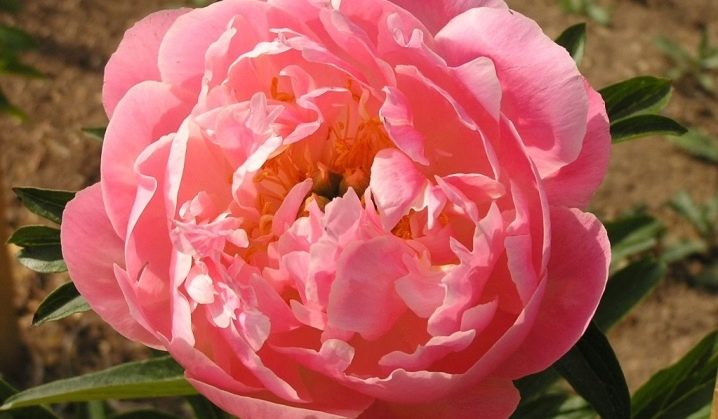
Coral Pink
This beautiful plant reaches 75 centimeters in height, has soft green carved leaves, as well as double flowers of a light pink hue. When opened, the bud reaches 13 centimeters in circumference.
Flowering begins in June and lasts about 3 weeks. This variety is very popular among gardeners due to its beauty and compactness.
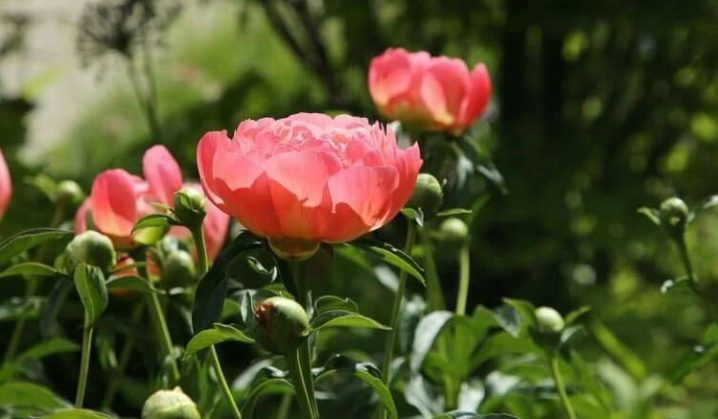
"Pink Hawaiian Coral"
This variety of peonies was bred in the 90s of the last century by American scientists. It is a perennial herb that grows up to one meter in height. Moreover, its stems are quite dense and dotted with green carved foliage.
The flowers are semi-double and large, up to 21 centimeters in diameter, with an apricot shade. They are very often used for cutting.
Flowering begins early - in April, and lasts up to 3 weeks (in cool weather, it can be more).
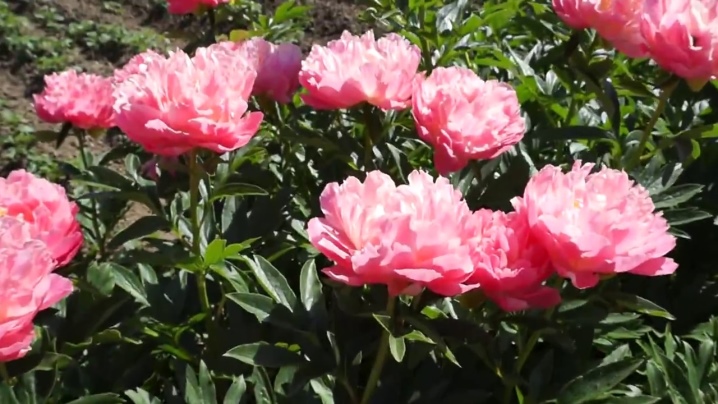
Coral Beach
The peony is distinguished not only by a beautiful and lush bush up to one meter in height, but also by its delicate coral color. The flower itself is small, up to 15 centimeters in diameter. Inflorescences are semi-double, with a yellow center. In its shape, the opened buds are a bit like lotus flowers.
A distinctive feature of this variety of peonies is their resistance to various temperature extremes, as well as to some fungal diseases. Thanks to this, it is very popular with many summer residents.

"Coral Fairies"
This variety of peonies is an interspecific hybrid. Its appearance dates back to the last century.The bush is low, up to 70 centimeters, dense stems with beautiful decorative leaves.
Coral semi-double buds, when opened, reach 15 centimeters in diameter and exude a delicate aroma.
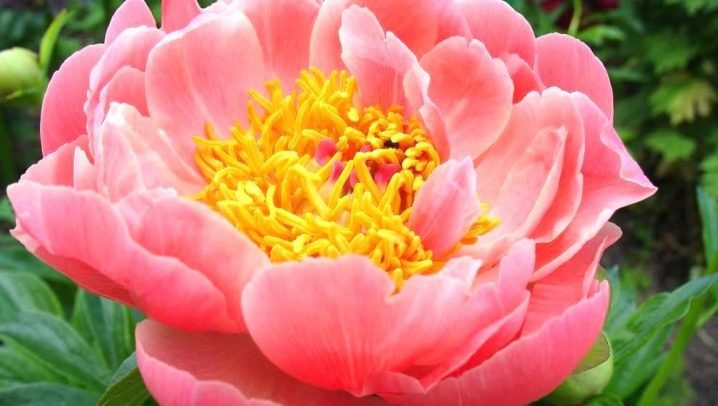
Coral Sunset
A very popular variety of peonies. It is compact, but at the same time the height of the plant reaches in some cases up to one meter.
On tall, erect stems, semi-double buds are placed, which have a pink-peach color with a shade of coral red. The leaves are green. Flowering starts early.
Coral Sunset has received many awards at various exhibitions, not only for its beauty, but also for its easy care and resistance to temperature extremes.
"Coral Magic"
This newly developed peony has amazed everyone with its colorful flowers. These are semi-double three-row buds with a very bright color, which are visible from afar.
In a circle they reach 15 centimeters, in the middle there are yellow stamens. The bush is compact and low, up to 70 centimeters. Erect stems with delicate green foliage. Flowering begins in April.
Coral Supreme
This hybrid plant is very rare. The bush has powerful stems that grow up to one meter in height. Its carved bright green leaves cover almost the entire bush, only the coral-salmon buds are visible at the very top.
When they open, they represent a bowl reaching up to 19 centimeters in diameter. In addition, during flowering, they exude a very delicate aroma.
Coral & Gold
With its unusual beauty, as well as large flowers, this variety of peony amazes everyone. Already in late March or early April, you can see terry coral buds on the tops of a huge, up to 95 centimeters high, bush.
When they bloom, their diameter can be up to 21 centimeters. In addition, the flowers exude a rich, sweet scent. The stems are decorated with green carved leaves.
"Topeka Coral"
Peonies of this variety are distinguished by terry bomb-shaped buds. At the beginning of flowering, their color is pink-red, but as they unfold, the flowers turn coral.
The Topeka Coral bush does not grow above 65 centimeters. The leaves are carved with a dark green color.
"Coral charm"
This variety of semi-double peonies is very popular among gardeners, so it is most often bought for planting in personal plots. Its color is very unusual: a pink dark flower, which, as it blooms, becomes coral with a delicate white border.
At the very end of flowering, it turns yellow. The bud itself is large, up to 22 centimeters in size, and consists of eight rows of petals.
Stems are straight and strong, with a reddish color. Peony leaves are green and carved. The height of the bush reaches a meter in height. Flowering begins in early June.
Diseases and pests
The plant can be infected with diseases and pests.
Gray rot
The entire bush is affected by a white bloom. Treatment takes place by cutting off the affected branches and spraying with a 0.6% Tiram suspension.
Powdery mildew
The disease spreads to adult bushes. Differs in a whitish bloom on the surface of the leaves. It is cured by spraying with a solution of soda ash and laundry soap.
Ants
Insects are attracted by the sweet smell of the plant. A solution of drugs with nicotinoids and pyrethroids helps to get rid of them.
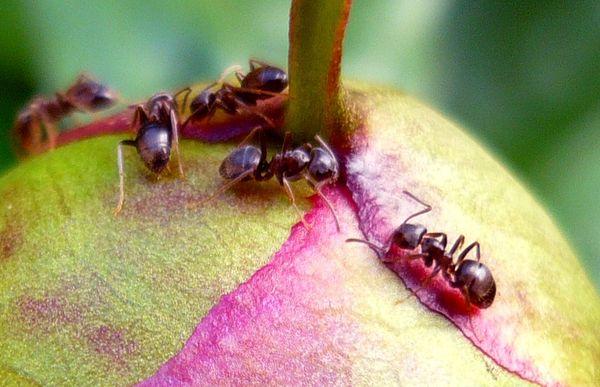
Bronzovka
The beetle eats the petals, foliage and stems of the plant. You can destroy the pest with insecticides or a solution from the tops of tomatoes.
Aphid
Small green insects drink juices from the plant. If there are many of them, the bush dies. You can save the culture with a strong pressure of water from a hose or treatment with Fitoverm, Aktellik.
Features of peonies "Red charm"
We have all the plants in pots! You can plant them all summer!
New entry to the Nursery from spring 2019
Photo of a herbaceous peony Red Charm
Description of peony herbaceous variety Red Charm
Herbaceous peony varieties Red Charm (Red Charm) - perennial with powerful fleshy root tubers. Plant height up to 90 cm. Large flowers (up to 22 cm) are double, dark crimson. The leaves are large, dissected, shiny. Very aromatic. Flowering period - early, duration up to 4 weeks. They are unpretentious to the soil, but grow better on fertilized soils.
Features of planting and growing.
Choosing a place for herbaceous peonies.
- Peonies require a well-lit place. They can withstand light shading. In the shade, the plants will either not bloom, or they will do it poorly.
- Peonies do not like the neighborhood with fruit plantations, with which they begin to struggle for nutrients.
- Peonies are not advised to plant next to buildings - in the summer, the bushes will overheat, and the flowers will be damaged by a drop from the roofs.
- Peonies do not tolerate stagnant water. If there is a possibility of bush flooding on the site, if possible, drainage should be done or planted on a hill. This should protect it from rotting of the root system. Otherwise, the plant will have poor development or even die.
- Peonies prefer moisture-absorbing and sufficiently breathable soil. Loamy soils are best suited for development. The reaction of the soil medium should be neutral or slightly acidic pH 6.0 - 7.0.
Planting and care of herbaceous peonies.
- The size of the landing pit should be 50 * 50 * 50 cm.
- A peony seedling should be planted in such a way that the rhizome is covered by 4-5 cm. If you deepen the plant, it will grow, but will not bloom. If you plant the plant too high, the winter hardiness of the plant will decrease.
- The feeding area of one bush is 1 - 1.5 m.
- Peonies should be fed in the spring. When planting, organic fertilizer (horse humus or humus) should be applied at the rate of 5-15 kg / m2; from mineral nutrition, you can take urea (50-100 g) or ammonium nitrate with nitroammoth (15-20 g each). In autumn, it is also possible to fertilize with various complex fertilizers, WITHOUT nitrogen content. On rich lands, top dressing is often not necessary, and on poor, sandy soils, fertilization must be applied annually.
- Young plants can also be fed foliarly. From the second half of May, spray with a complex mineral readily soluble fertilizer. Like watering, this operation should be done either in the morning or in the evening to avoid sunburning the foliage.
- In the first year after planting, it is recommended to cut the buds. In the future, to obtain larger buds, one bud should be left on one shoot. The buds should be removed while they are embedded in the steel about 1 cm in diameter.
- Watering peonies should be carried out immediately after planting during the first 3-4 weeks several times a week. In the future, the plant is watered as needed. An adult bush requires 15-25 liters of water. It is better to water less often, but more thoroughly than more often, but shallowly. After watering, the ground in the near-trunk circle is loosened
It is very important that the soil is well moistened before flowering, that is, in late spring and August, during the laying of flower buds.
- The trunk circle is required when growing peonies. No plants should be planted in it, it must be kept clean of weeds; loosen constantly. If desired, you can separate the area of the trunk circle from the lawn with a curb tape (you cannot use iron sheets or concrete products for these purposes).
- In autumn, the entire aboveground part is cut off and disposed of (compost pit or fire)
Where to buy a dark red peony in Moscow inexpensively? What variety of peonies is the most winter-hardy? Which variety of peonies is the most beautiful?
We will help you find the answer to these and other questions! Just call or come to our nursery!
Varieties
Varieties and varieties of flowers are extremely important for any gardener to know.Consider examples of some varieties
Raspberry Sunday
It is customary to refer the "Raspberry Sunday" peony to the milky-flowered group. The plant is no less beautiful than its tree-like counterparts. Particularly complex care is not required. The growth is rapid. In many respects, this peony owes its developed root system.
The height of the stems is up to 1 m, their strength is moderately high. The leaves are narrow and medium-sized. Flowering starts early. At the same time, flowers are formed that resemble scattered large caps; their diameter is up to 0.18 m.
The development of petals with different textures is possible:
- semi-double;
- single;
- terry.
The descriptions indicate a wide variety of colors. There are also white peonies "Raspberry", and bright pink specimens. Even from the photo, it is easy to imagine how elegant they look. Occasionally, red, yellow flowers can be found. A terry bomb-shaped peony (an example of which is the Raspberry Sunday) can look attractive all summer long.
The culture forms fleshy roots similar to tubers. The foliage is dissected. The doubleness of the flowers reaches a large value. The name of the plant species - bomb-shaped peony - is given because of the magnificent appearance of the blossoming flower. The color is quite different.
Raspberry charm
"Raspberry charm" (full name - "Red charm") is highly appreciated by Russian growers. The plant forms very large red flowers. Even a very bright sun does not lead to a loss of brightness. The ball can reach 0.25 m in diameter. The stems are strong enough - they do not bend, even if a powerful flower cap is formed.
Raspberry ice
This peony of the versatile group is also noteworthy. Its main characteristics:
- blooms in medium terms;
- forms wide petals of the lower tier;
- grows up to 1 m;
- is resistant;
- outwardly handsome;
- fragrant.
Gloing Raspberry Rose is another peony from the bomb group. Its smell is weak. The height of the bush is 0.9-1 m. There are flowers of 3 different tones at the same time.


